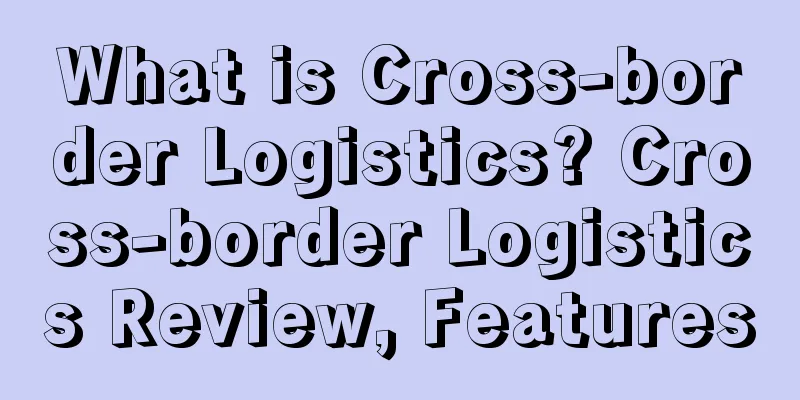What is Cross-border Logistics? Cross-border Logistics Review, Features

|
Cross-border logistics refers to the process of planning, implementing, controlling and managing the effective flow and storage of physical objects and information with both sides of the customs border as endpoints. Cross-border logistics can also be understood as international logistics, which refers to the spatial transfer of goods from one country to another, thereby completing the ultimate goal of international commodity trading.
About cross-border logistics Cross-border logistics must pass through two customs borders, so cross-border logistics is bound to be inseparable from the customs clearance/clearance process. On the Chinese side of the border, in order to solve the problems of cumbersome customs clearance and taxation in cross-border logistics in export and import e-commerce in the past, logistics companies represented by China Post and SF Express are combining the new cross-border e-commerce supervision model proposed by the General Administration of Customs and cooperating with the cross-border customs clearance service platform in the cross-border e-commerce pilot cities to achieve rapid customs clearance for imports and exports.
Main Mode 1. International parcel (postal parcel) (1) Overview: According to incomplete statistics, 70% of the parcels of China's cross-border e-commerce export business are delivered through the postal system, of which China Post accounts for about 50%. Hong Kong Post and Singapore Post are also commonly used logistics methods for Chinese cross-border e-commerce sellers. (2) Advantages: The postal network covers almost the entire world, which is wider than any other logistics channel. Moreover, since the postal service is generally state-owned and subsidized by the state, the price is very cheap. (3) Disadvantages: Generally, the goods are shipped abroad in the form of private parcels, which is not convenient for customs statistics and cannot enjoy normal export tax rebates. At the same time, the speed is slow and the package loss rate is high. 2. International Express (1) Overview: International express delivery mainly refers to the four giants UPS, FedEx, DHL and TNT. International express delivery has high requirements for the provision, collection and management of information, and is supported by a global self-built network and international information system. (2) Advantages: fast speed, good service, low packet loss rate, especially convenient for sending to developed countries in Europe and the United States. (3) Disadvantages: Expensive, and price fluctuations are large. Generally, cross-border e-commerce sellers will only use it when customers strongly demand timeliness, and will charge customers for shipping. 3. Overseas warehouse (1) Overview: Overseas warehousing services refer to one-stop control and management services for warehousing, sorting, packaging and delivery of goods provided independently or jointly by online foreign trade trading platforms and logistics service providers to sellers at the sales destination. Sellers store goods in local warehouses, and when buyers have needs, they respond quickly and sort, pack and deliver goods in a timely manner. The entire process includes three parts: first-leg transportation, warehousing management and local distribution. (2) Advantages: Using traditional foreign trade methods to deliver goods to warehouses can reduce logistics costs; it is equivalent to sales occurring locally, and can provide flexible and reliable return and exchange solutions, thereby increasing overseas customers' purchasing confidence; the delivery cycle is shortened and the delivery speed is accelerated, which can reduce the transaction rate of cross-border logistics defects; overseas warehouses can help sellers expand their sales categories and break through the development bottleneck of "big and heavy". (3) Disadvantages: Not all products are suitable for using overseas warehouses. It is best to use hot-selling items with fast inventory turnover, otherwise it is easy to have inventory pressure. At the same time, it puts higher requirements on sellers in terms of supply chain management, inventory control, and sales management. 4. Cross-border dedicated logistics (1) Cross-border dedicated logistics generally involves transporting goods to foreign countries by chartering air cargo, and then delivering them within the destination country through a cooperative company. It is a relatively popular logistics method. (2) Advantages: Large quantities of goods are sent to the destination in a centralized manner, reducing costs through economies of scale. Therefore, the price is lower than commercial express delivery, the speed is faster than postal parcels, and the package loss rate is also relatively low. (3) Disadvantages: Compared with postal parcels, the freight cost is still much higher, and the collection range in China is relatively limited, and the coverage area needs to be expanded. 5. International services for domestic express delivery (1) Overview: With the increasing popularity of cross-border e-commerce, domestic express delivery companies have also begun to accelerate the layout of international business. For example, EMS and SF Express have made great efforts in cross-border logistics. (2) Advantages: Faster delivery speed, lower cost than the four major international express giants, and EMS has strong customs clearance capabilities in China. (3) Disadvantages: Since it does not focus on cross-border business and is relatively inexperienced, its ability to control the market needs to be improved, and its overseas market coverage is relatively limited.
Features 1. Competition is concentrated in the southeastern coastal areas, while there is less competition in the central and western regions. Due to the developed economy in the southeastern coastal areas such as the Bohai Sea Rim, the Yangtze River Delta, and the Pearl River Delta, there is a strong demand for cross-border transportation, and the relatively complete infrastructure such as sea and air transportation in the region, so the competition for cargo sources and transportation resources is the most intense. In the central and western regions, due to the relatively inactive economy, there is less demand for cross-border transportation, and the transportation cost is higher, so the region has less investment in international freight forwarding service resources. 2. Competition within a region or a single industry is fierce, while cross-regional and cross-industry competition is less. Although there are many market competitors in the cross-border logistics industry, due to the limitations of their own financial strength, management and technical capabilities, as well as the fragmentation of the national logistics market, the competition is manifested in the competition between companies in a certain regional market, such as the competition between cross-border logistics companies in the Yangtze River Delta region; or the competition for customer resources in a certain industry, such as the competition for customer resources in the electronics manufacturing industry, while there is less cross-regional and cross-industry competition. 3. The service functions are single, there are few value-added services, and homogeneous competition is more serious. Most cross-border logistics companies can only provide sea or air logistics services. There are few cross-border logistics companies that can provide multimodal transport (such as sea-air transport) and meet other different needs of customers. When providing cross-border logistics services, they are limited to traditional services such as customs declaration and booking. They provide fewer optimized transportation solution designs and comprehensive logistics services. Therefore, the phenomenon of homogeneous competition is more serious.
status quo 1. High operating costs: In the development of enterprises, the cost issue is of great concern, because the ultimate goal of enterprises is to make profits. Of course, the cross-border e-commerce logistics industry will also face this problem, and it is an issue that must be considered. Under the current background, it faces the problem of relatively high operating costs. Therefore, in the future development, ensuring the reduction of cross-border logistics operating costs is the focus of the business logistics industry. 2. The basic equipment of logistics services needs to be improved: A careful study of the infrastructure of the current logistics industry shows that the relevant facilities are in urgent need of further improvement and optimization, which is a drawback that cannot be ignored. From the perspective of the industry as a whole, research and analysis of the logistics of cross-border e-commerce shows that there are some loopholes in its infrastructure, which affects its own development and the development of cross-border e-commerce. Compared with the domestic logistics industry, cross-border logistics has its own characteristics. Cross-border logistics has the link of customs declaration, which is the most typical problem faced by the logistics of cross-border e-commerce. If you want to improve the overall logistics speed, you must solve this problem, set up professional personnel and build special infrastructure, thereby improving the efficiency of customs declaration and improving infrastructure construction. 3. Logistics technology level needs to be improved: From the perspective of the logistics industry as a whole, it is necessary not only to improve the overall service quality, but also to improve the overall technical level, master more advanced technologies, and apply them to all aspects of logistics to promote its overall development. The logistics of cross-border e-commerce should also focus on the mastery of technology and continuously improve the scientific level of all aspects of logistics, so as to meet the increasing market demand and promote the development and prosperity of the logistics industry of cross-border e-commerce. |
<<: What is Forwarding Company? Forwarding Company Review, Features
>>: What is Selling Manager? Selling Manager Review, Features
Recommend
Cross-border sellers flee European sites
Europe has always been a key market for many cros...
Amazon plans to enter South Africa as Generation Z drives online shopping boom
At present, e-commerce giant Amazon does plan to ...
What is Fork Intelligence? Fork Intelligence Review, Features
Fork Intelligence is a robotic process software th...
Social media advertising will become popular in 2022, with 98% of advertisers placing ads on Facebook
Social media platforms have been gaining populari...
Amazon's warehouses are overflowing at many sites, making warehousing a problem!
Black Friday and Cyber Monday have just passed,...
What is Wish Local? Wish Local Review, Features
Wish Local is full of second-hand goods (about 80...
What is Poweradspy? Poweradspy Review, Features
Poweradspy is an ad tracking and monitoring tool ...
What is Analyzer.Tools? Analyzer.Tools Review, Features
Analyzer.ToolsBulk analysis, sourcing and profit ...
Huge potential! Get the three major trends of e-commerce and logistics in the Philippines in the next five years
The pandemic has further fueled the market’s grow...
Third-party seller service revenue hits a new high, will Amazon reduce its own-operated share?
On July 28th local time, Amazon released its seco...
What is Atlas? Atlas Review, Features
Atlas was founded with the goal of creating the mo...
Search volume increased by 1374%! In the heavy snow, these summer products are booming
A few days ago, the "Chinese antique" s...
Priced at over 7 billion! Amazon sells itself to industry giants
Another big Amazon brand has been acquired! Ghost...
What is Chubb Limited? Chubb Limited Review, Features
Chubb is the world's largest property and cas...
Sales surged 40%! Korean high-priced kitchen supplies are now in high demand
Due to the impact of the epidemic , most Korean p...









